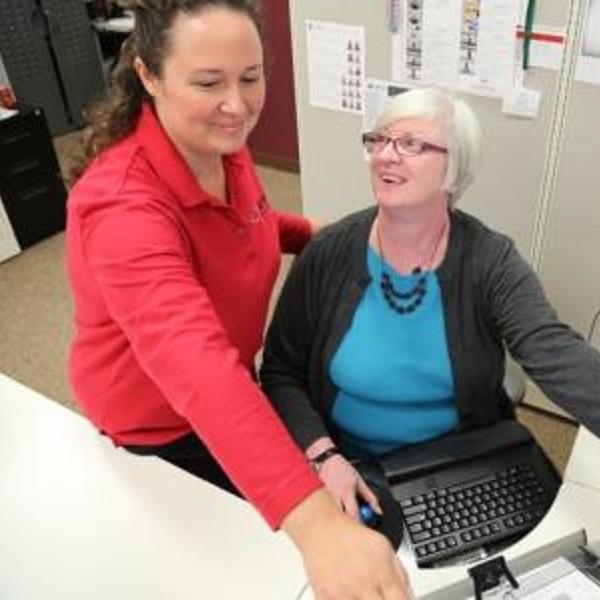Turtling: Why Your Eyesight May Be Linked to the Pain in Your Neck and Shoulders

Authored by Kristin Geary, MS, ATC/L, CEAS II, Certified Early Intervention Specialist, ATI Worksite Solutions, Indianapolis
Do you ever find yourself craning your neck to see your computer screen? Vision plays a critical role in most job functions, and the office environment is no exception. Cynthia Roe Purvis, who was the Ergonomics R&D Program Director for HP, now retired, has coined the term "turtling," referring to the common posture we see in offices today - forward head posture and slumped spine. At the National Ergonomics Conference and Exposition, Purvis pointed out that we need increased workplace awareness on the role vision plays in discomfort:
- Thirty to sixty percent of computer users report pain or stiffness in the neck, shoulders, or upper back.
- Many studies have found that 50-90% of users report vision-related discomforts such as eye strain, irritation, blurring, and dry eyes.
By the year 2020, it is estimated that half the workforce will be over age 45 - many of whom will be dependent upon progressive addition lenses (PAL). PAL are designed so that the top of the lens contains the prescription for distance, the bottom for near, the outer sides for aberration, and just a tiny dot in the center of the lens for intermediate distance. It is this small dot in the center that is used for computer viewing.
In order to position the head to see through the appropriate part of the lens, the user may subconsciously tilt their head back or crane the neck ("turtle-necking"). Either one will place the neck into a position where it has to leverage the weight of the head. Keeping in mind that the head is the heaviest part of the body (12-15 lbs.), we need to realize the added impact of leveraging. According to whatsyourposture.com, for every inch the head is forward, the employee adds an equivalent to 10 extra pounds of force on the neck. With muscles in constant contraction, pressure is added to the nerves at the base of the skull, often resulting in headaches. This posture is also associated with decreased respiratory strength; affecting the capacity to breath and reducing lung capacity by as much as 30%.
Research has found the causes for "turtling" in addition to PAL include: font size, display adjustment, display stand/insufficient range, viewing distance, glare, and uncorrected vision. In addition, using multiple monitors usually results in people pushing the screens further away in order to reduce neck rotation, therefore, increasing the need to increase the font size. Key point: Body awareness is crucial to office ergonomics.
In the training we conduct for ATI Worksite Solutions clients, we emphasize that despite state-of-the-art ergonomic furniture, the risk of injury is still present if employees don't take the time or don't have the knowledge to adjust the furniture to fit them properly.
Some tips for multi-focal (PAL) wearers:
- Adjust the screen to 16-18 degree gaze angle to center of display.
- For dry eyes: lower gaze angle for increased eye lid coverage. (And don't forget to blink.)
- Increasing the font size through either the "Control-Scroll" feature or magnification software.
- Try small, incremental adjustments to the screen position (height, depth, and tilt).
- Make sure your eye prescription is up to date.
Another option is asking your Optometrist about computer glasses. These glasses use the prescription of the tiny dot (intermediate distance) as the entire lens. These glasses are only to be worn while working at the computer.
One of the key takeaways from the presentation was that "no one display placement keeps all body parts happy at all times." Increased use and abundance of touch devices are changing the traditional way of thinking about ergonomics. Not only do we have to keep vision and viewing distance in mind, but now we have touch-display devices to keep within easy reaching range for the hands.
iPads are becoming more common in most workforces, so we must also start thinking about how to best incorporate touch-device recommendations into our standard training and assessments. While accessories such as an external Bluetooth keyboard, a stand to raise the screen, etc. make touch devices more ergo-friendly, they do not address the fact that stylus or finger touch to the screen is still required.
No doubt ergonomic obstacles will only become more prevalent with increasing electronic items on the market and an aging workforce. It is imperative that we encourage employees to move frequently, changing work positions throughout their day.
ATI Worksite Solutions (AWS) partners with employers to analyze and address their challenges with the delivery of programs designed to mitigate risk and decrease costs. AWS Certified Early Intervention Specialists observe and coach employees at their work site to correct the root causes of the discomfort while providing education on safe body mechanics and posture. Sessions are followed by one-on-one job coaching opportunities to reinforce key training points. For more information, please visit ATI Worksite Solutions.
